
The ATLAS Collaboration pioneered the search for semi-visible jets, a potential dark matter signature arising from dark quarks and gluons in a strongly interacting dark sector. Despite the challenges and no direct findings, this novel research sets the first limits on semi-visible jet production, paving the way for more nuanced dark matter searches in the future.
What happens if dark-matter particles are produced inside a jet of Standard-Model particles? This leads to a novel detector signature known as semi-visible jets! The ATLAS Collaboration has come up with the first search for semi-visible jets, looking for them in a general production mode where two protons interact by exchanging an intermediate particle, which is then converted into two jets.
The elusive nature of dark matter remains one of the biggest mysteries in particle physics. Most of the searches have so far looked for events where a “weakly interacting” dark-matter particle is produced alongside a known Standard-Model particle. Since the dark-matter particle cannot be seen by the ATLAS detector, researchers look for an imbalance of transverse momentum (or “missing energy”).

The ATLAS Collaboration has conducted the first search for semi-visible jets, a potential signature for the presence of dark matter particles. These are hypothesized to occur when two protons interact, generating an intermediate particle that then transforms into two jets. Credit: ATLAS Collaboration/CERN
However, some theoretical models predict a “strongly interacting” dark sector, with dark quarks and gluons as replicas of Standard-Model quarks and gluons. Semi-visible jets would arise when dark quarks decay partially to Standard-Model quarks and partially to stable dark hadrons (the “invisible fraction”). Since they are produced in pairs, typically along with additional Standard-Model jets, the missing energy arises when all the jets are not fully balanced. The direction of the missing energy is often aligned with one of the semi-visible jets, as can be seen in the event display above.
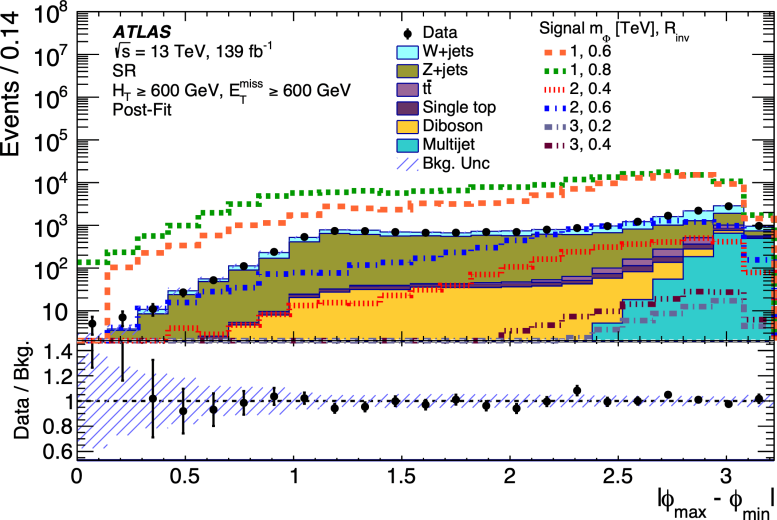
Figure 1: The data, background and six predicted signal distributions covering a representative mediator mass and invisible fraction range are overlaid for the azimuthal angular difference between the two semi-visible jets candidates. Excellent agreement between data and background is observed. Credit: ATLAS Collaboration/CERN
This makes searches for semi-visible jets very challenging, as this event signature can also arise due to mis-measured jets in the detector. For their new search, physicists had to make sure all such effects had been accounted for. To do this, they focused on a few observables: the uniqueness of the alignment and magnitude of transverse momentum, and the angle between the semi-visible jets. They also investigated scenarios with different invisible fractions and mediating particle masses.
After accounting for all the Standard-Model processes contributing to this event topology, researchers found no hint of semi-visible jets. As can be seen from Figure 1, which shows the angular difference between the two semi-visible jet candidates, the data follows the Standard-Model background shape. Dark-matter signals were expected to have a slightly different shape.
The search for semi-visible jets very challenging, as its event signature can also arise due to mis-measured jets in the detector. How did ATLAS researchers overcome this challenge?
This novel result sets the first limits on this specific semi-visible-jet production scenario, shown in Figure 2 as functions of both the mediator mass and the invisible fraction. The search is more sensitive at intermediate values of the invisible fraction, and excludes mediator masses up to 2.7 TeV. Researchers were also able to report the number of data events observed corresponding to the event selection requirements. This sets important groundwork for future searches for dark matter, enabling physicists to build semi-visible-jet models that take into account the existing constraints on this signature.
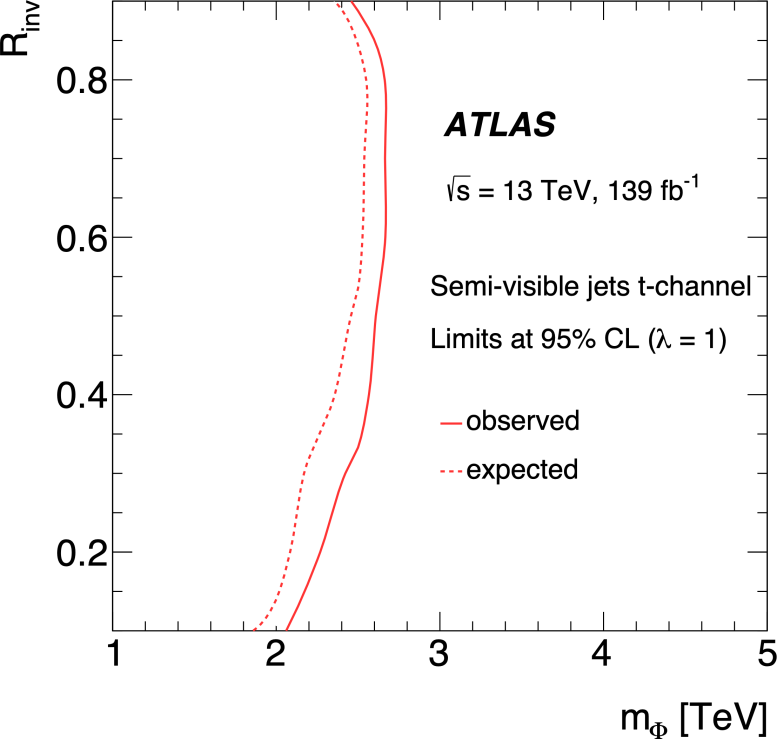
Figure 2: The expected and observed exclusion contours for semi-visible jets signal as a function of mediator mass on the x-axis, and the invisible fraction on the y-axis. Mediator masses on the left-hand side of the red solid line are excluded for the given invisible fraction. Credit: ATLAS Collaboration/CERN
There’s still a lot left to explore! ATLAS researchers plan to systematically study all possible signatures from the strong dark sector landscape, which may include uncovered signatures like the one considered in this search. As the ATLAS experiment continues to grow its mammoth dataset, it will provide new opportunities for exploration and new options to extend the search for semi-visible jets.

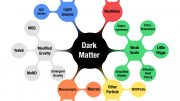
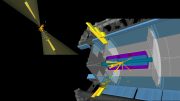

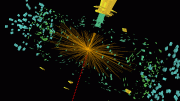
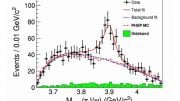


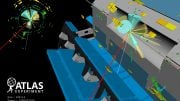
Dark matter looks to me as a witch hunt. There is of course a possibility that we are not searching in the right place or, our tools are not strong enough.
But… dark matter remains just a story for our brain, just like the stories about gods.
i suggest we should try alternative stories, like unsuccessful the quantized inertia of McCullough.
It would be interesting to ask young physisists to employ a trained LLM like GPT-4 or its advanced clones that OpenAI tests currently, to suggest new alternative theories about the motion the galaxies. These creatures produce already significant creativity and thinking out of the box.
I’m reminded of an old baseball diamond comedy bit from Abbott and Costello – “Who’s on first?” If ubiquitous cosmic scale holographic projection features may help explain quantum gravity, there’s apparently at least one ubiquitous target to be found in the search for signs of quantum effects associated with gravity in the cosmos, and it’s not necessarily resembling an eyeball or a diamond, but some may differ on that, fate can throw a person some twists and you can never be too sure.
“What’s the target object supposed to resemble?”
“It looks just like a target.”
“Fine, sure, but what does it look like?”
“I told you already!”
It’s a “very ubiquitous cooled-off galaxy-form sort of perspective” kind of parody, if you need it dissected here. Also have some stories about Log of Gaussian edge detection image kernels for convolutional neural nets, but those must wait for later.